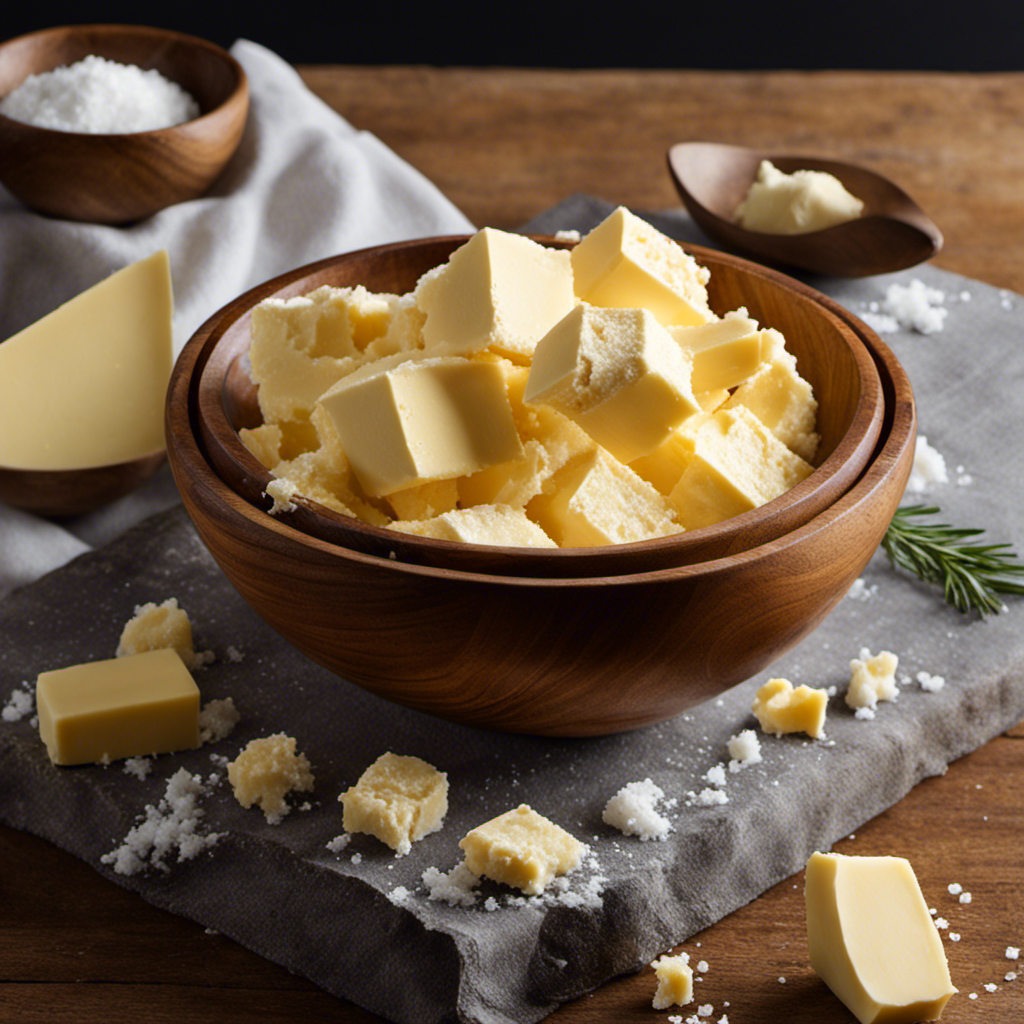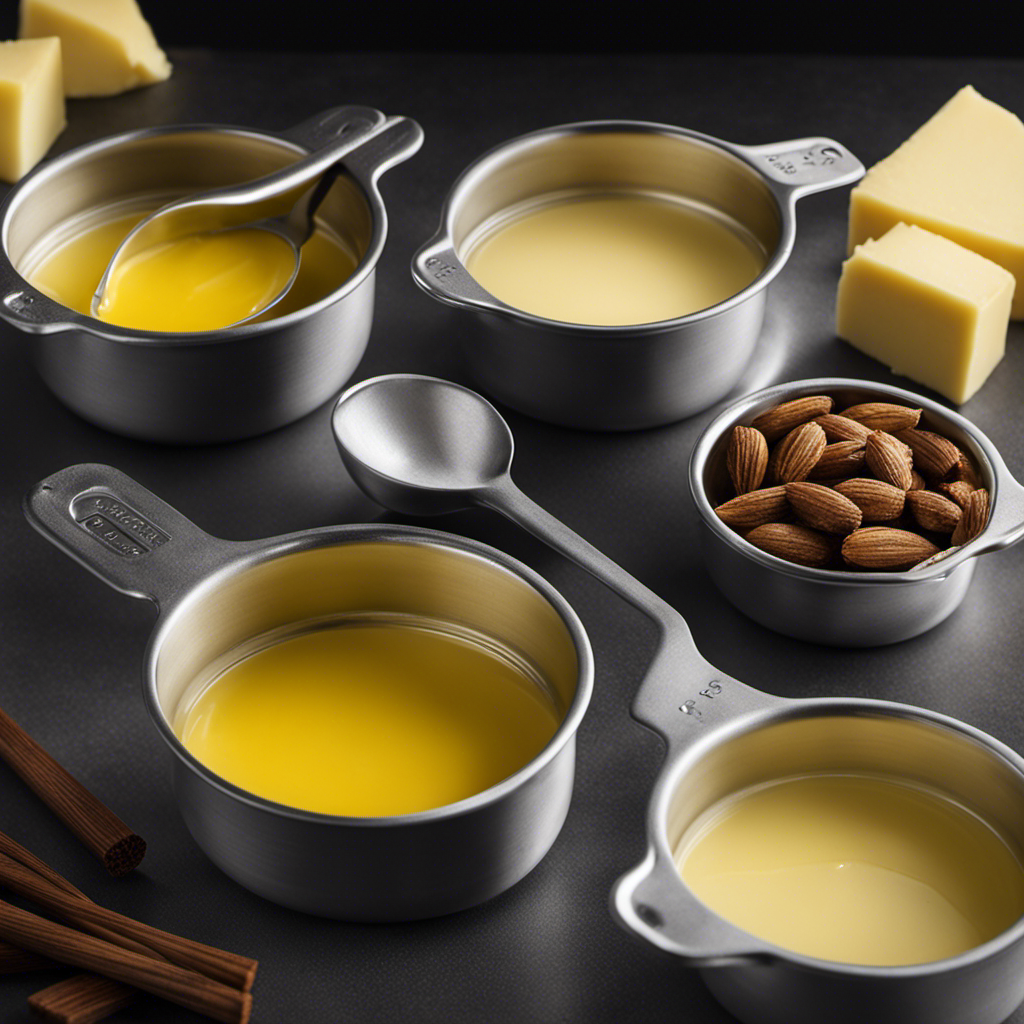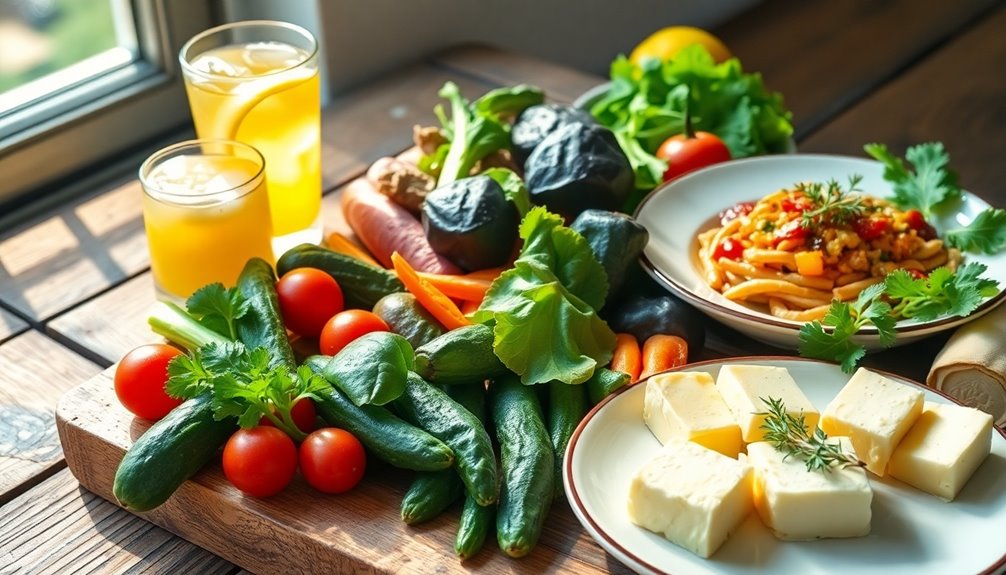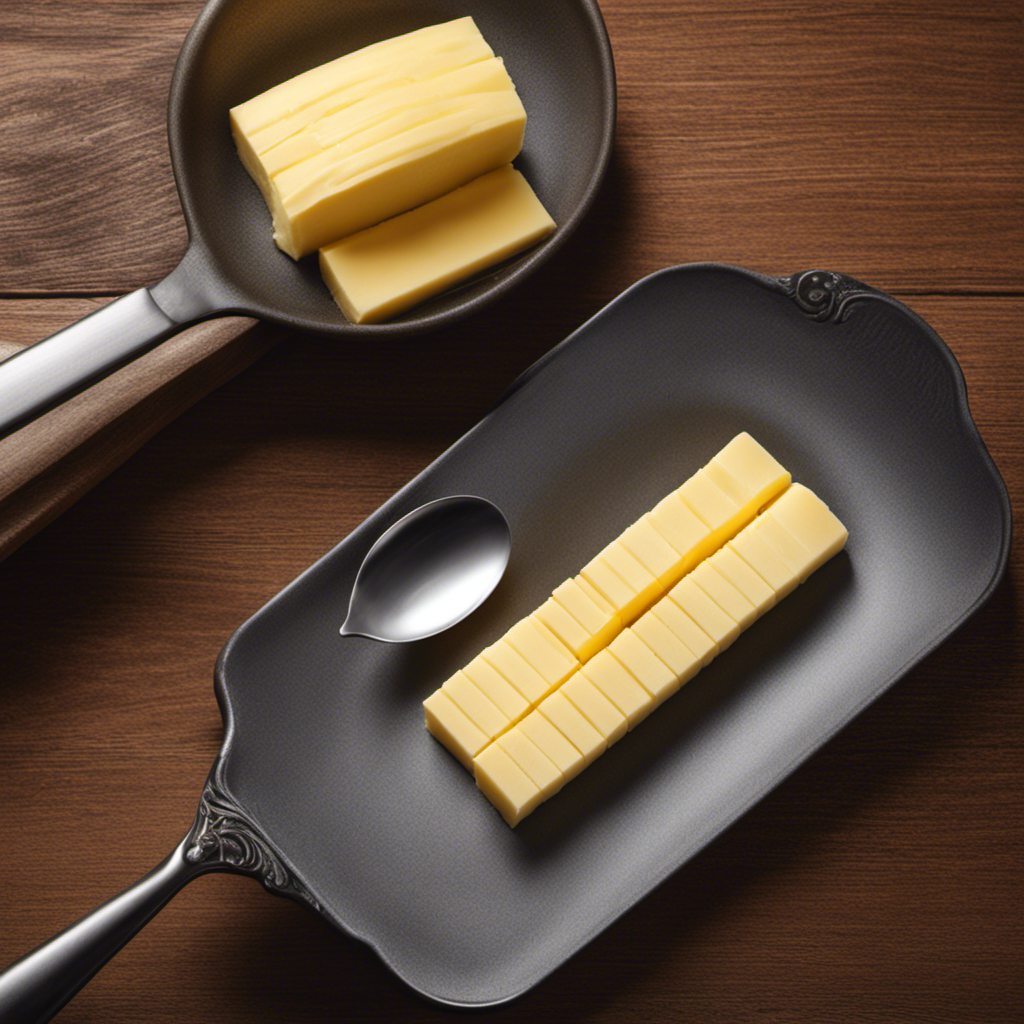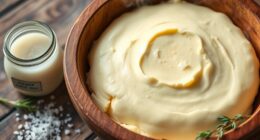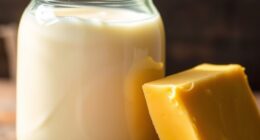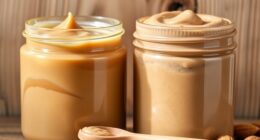I can understand your concern: measuring butter accurately can be challenging. However, do not worry, as I am here to demonstrate the foolproof method for measuring 2/3 cup of butter.
Whether you’re a novice in the kitchen or a seasoned pro, this step-by-step guide will ensure you get the perfect amount every time. From understanding measurements to using the right tools, I’ll walk you through the process, providing helpful tips and tricks along the way.
Get ready to master the art of measuring butter!
Key Takeaways
- Butter can be measured in units such as cups, tablespoons, and grams.
- 2/3 cup of butter is equivalent to 10 and 2/3 tablespoons or approximately 150 grams.
- Understanding measurements and conversions is crucial for accurate measurement.
- Measuring tools such as measuring cups, measuring spoons, and a kitchen scale are essential for precise measurements.
Understanding Measurements
Understanding measurements is crucial when it comes to accurately measuring ingredients, such as butter. When it comes to measuring butter, it’s important to know the different measurement units and potential alternatives.
The most common unit of measurement for butter is the cup. However, there are also other options like tablespoons or grams. It’s essential to have a good grasp of these units and their conversions in order to follow recipes accurately.
For example, if a recipe calls for 2/3 cup of butter, you should know that this is equivalent to 10 and 2/3 tablespoons or approximately 150 grams.
Tools for Measuring Butter
To accurately measure 2/3 cup of butter, grab a measuring spoon or scale. There are several alternatives for measuring butter, each with their own pros and cons. Let’s take a closer look at the different measuring tools and their benefits and drawbacks:
| Measuring Tool | Pros | Cons |
|---|---|---|
| Measuring Spoon | – Easy to use | |
| – Can measure small amounts accurately | – Limited to specific measurements | |
| – Can be messy | ||
| Scale | – Provides precise measurements | |
| – Can measure any amount | – Requires additional equipment | |
| – Takes longer to measure |
Using measuring spoons is a popular choice for measuring butter, as they are easy to use and can accurately measure small amounts. However, they have limitations in terms of available measurements and can sometimes result in a messy process. On the other hand, a scale offers precise measurements and can be used for any amount of butter. However, it requires additional equipment and takes longer to measure.
Now, let’s explore the first method for measuring butter: using measuring cups.
Method 1: Using Measuring Cups
Using measuring cups is a simple and convenient way to accurately portion out the desired amount of butter. When it comes to understanding measurements, it’s important to know that 1 cup of butter is equal to 16 tablespoons or 8 ounces.
To measure 2/3 cup of butter, you can use a 1 cup measuring cup and fill it up to the 2/3 mark. Another alternative measuring method is using a scale that can measure in grams or ounces.
To measure 2/3 cup of butter using a scale, you would need to know that 1 cup of butter is approximately 227 grams or 8 ounces. You can then measure out 2/3 of this amount, which would be around 151 grams or 5.3 ounces.
Method 2: Using a Kitchen Scale
When it comes to accurate butter measurement, using a kitchen scale can be extremely helpful. Not only does it provide precise measurements, but it also eliminates any guesswork or inconsistencies that may arise with other methods.
While measuring cups are a common alternative, a kitchen scale offers greater accuracy and ensures that your recipes turn out just right.
Accurate Butter Measurement
Measuring butter accurately can be tricky, but there are a few tips and tricks you can use.
Here are three ways to ensure precise measurements when working with butter alternatives:
-
Use a kitchen scale: Weighing the butter on a scale will give you the most accurate measurement. Simply place a container on the scale, zero it out, and add the desired amount of butter.
-
Utilize measuring spoons: If you don’t have a kitchen scale, measuring spoons are a great alternative. One tablespoon of butter is equal to 1/8 of a cup, so you can use this conversion to measure out the desired amount.
-
Follow the markings on the wrapper: Most butter wrappers have measurements marked on the sides, making it easy to slice or cut the butter according to your needs.
Benefits of Using Scale
To get the most precise measurements, you’ll want to utilize a kitchen scale. The benefits of precision cannot be overstated when it comes to cooking and baking.
Accuracy is of utmost importance in achieving consistent results and ensuring that your recipes turn out just right every time. A kitchen scale allows you to measure ingredients with incredible accuracy, down to the gram or ounce. This level of precision can make a significant difference in the final outcome of your dishes.
Whether you’re measuring flour, sugar, or butter, a scale ensures that you’re using the exact amount required by the recipe. By using a scale, you can have confidence in the accuracy of your measurements and enjoy the benefits of precision in your cooking and baking.
Now let’s explore some alternative measuring methods.
Alternative Measuring Methods
Now that we’ve discussed the benefits of using a scale for measuring ingredients, let’s explore some alternative methods for measuring without tools. Sometimes we find ourselves in a situation where we don’t have access to measuring cups or spoons, but that doesn’t mean we can’t still get accurate measurements.
Here are three ways you can eyeball measurements:
-
Use your hand: Did you know that the size of your thumb can be used to estimate a teaspoon? The tip of your thumb is roughly equivalent to about a teaspoon of liquid or granulated ingredients.
-
Compare to common objects: You can also use everyday objects as a reference point. For example, a tablespoon of butter is approximately the size of a poker chip or a half-dollar coin.
-
Visualize fractions: If you’re trying to measure something like 2/3 cup of butter, imagine dividing a standard measuring cup into three equal parts and then filling it up to the two-thirds mark.
While these methods may not be as precise as using tools, they can still give you a good approximation when you’re in a pinch.
Converting Measurements
When it comes to converting measurements in the kitchen, understanding the differences between the metric and imperial systems is important.
Metric measurements are based on units of 10, making them more straightforward for conversions. However, many recipes still use imperial measurements, so knowing common conversion factors is essential.
Additionally, having the right measuring utensils, such as cups, spoons, and a kitchen scale, will make the conversion process easier and more accurate.
Metric Vs. Imperial
You can easily convert measurements between the metric and imperial systems. As someone who loves to cook, I often find myself needing to convert recipes from one system to another. Here are three things I’ve learned about metric vs. imperial measurements and converting them:
-
Familiarize yourself with the conversion factors: Knowing the conversion factors between the two systems is essential. For example, 1 inch is approximately 2.54 centimeters, and 1 pound is around 0.45 kilograms.
-
Use online converters: There are plenty of online converters available that allow you to quickly and accurately convert measurements. Simply enter the value you want to convert and select the desired units.
-
Practice makes perfect: Like any skill, converting measurements takes practice. The more you do it, the more comfortable and efficient you’ll become. So don’t be afraid to experiment and try converting different measurements in your everyday life.
Common Conversion Factors
To convert measurements between the metric and imperial systems, it’s helpful to know the conversion factors for common units like inches, centimeters, pounds, and kilograms. Understanding these conversion factors allows for precise and accurate measurements when converting between different units of measurement. Here is a table showcasing some common conversion factors:
| Conversion Factors | Metric to Imperial | Imperial to Metric |
|---|---|---|
| Inches to Centimeters | 2.54 cm | 0.39 in |
| Pounds to Kilograms | 0.45 kg | 2.20 lbs |
| Centimeters to Inches | 0.39 in | 2.54 cm |
Measuring Utensils Needed
Using the correct measuring utensils is essential for accurate and consistent results in baking and cooking. Here are three common measuring utensils that are crucial in the kitchen:
-
Measuring Cups: These come in various sizes and are used to measure both dry and liquid ingredients. It’s important to use the correct measuring cup for the specific ingredient being measured. For liquid ingredients, use a clear measuring cup with markings on the side. For dry ingredients, use a solid measuring cup with flat edges for accurate leveling.
-
Measuring Spoons: These smaller utensils are used to measure small amounts of ingredients like spices, baking powder, or vanilla extract. They typically come in sets with measurements ranging from ¼ teaspoon to 1 tablespoon.
-
Kitchen Scale: While not a traditional measuring utensil, a kitchen scale is handy for precise measurements, especially when it comes to baking. It allows you to measure ingredients by weight, which can be more accurate and consistent than using volume measurements.
Tips and Tricks for Accurate Butter Measurement
For accurate butter measurement, it’s important to use a measuring cup specifically designed for liquids. However, there are times when you may not have the necessary tools on hand to measure butter accurately.
In such cases, there are a few tricks you can use to estimate butter quantities. One method is to use the markings on the butter wrapper. Most standard sticks of butter have measurements printed on the packaging, typically indicating tablespoons and cups. By using these markings as a guide, you can estimate the amount of butter you need.
Another method is to use a kitchen scale. If you have a kitchen scale, you can weigh the butter to get an accurate measurement. Simply place a bowl on the scale, tare it to zero, and then add the desired amount of butter.
These tricks can help you measure butter without the need for specialized tools, ensuring your recipes turn out just right.
Frequently Asked Questions
Can I Use a Regular Cup Instead of a Measuring Cup to Measure 2/3 Cup of Butter?
No, using a regular cup instead of a measuring cup may not give you an accurate measurement for 2/3 cup of butter. It’s best to use a measuring cup for precise results.
How Can I Measure 2/3 Cup of Butter if I Don’t Have a Kitchen Scale or Measuring Cups?
To measure 2/3 cup of butter without measuring cups or a kitchen scale, I can use a regular cup and fill it 2/3 full. This method is a simple and easy way to convert measurements using different units.
Is It Possible to Measure Butter Using Tablespoons Instead of Cups?
Yes, it is possible to measure butter using tablespoons instead of cups. However, using a kitchen scale for accurate measurements is recommended to ensure precise results.
Can I Use a Different Type of Fat, Like Margarine or Shortening, Instead of Butter When Measuring 2/3 Cup?
Yes, you can use margarine or shortening instead of butter when measuring 2/3 cup. However, it’s important to note that the taste and texture of baked goods may vary when using different types of fat.
Are There Any Shortcuts or Alternative Methods for Measuring 2/3 Cup of Butter Accurately?
There are alternative methods for measuring 2/3 cup of butter, such as converting grams to tablespoons. It’s important to be accurate and precise when measuring to ensure the right amount is used in recipes.
Conclusion
In conclusion, measuring 2/3 cup of butter is an essential skill in baking and cooking. Whether you choose to use measuring cups or a kitchen scale, accuracy is key in achieving the desired results.
Interestingly, did you know that using a measuring cup can sometimes result in slightly more butter being used compared to using a kitchen scale? This small difference can affect the texture and consistency of your baked goods.
So, next time you’re in the kitchen, make sure to measure your butter accurately for the best outcomes!

